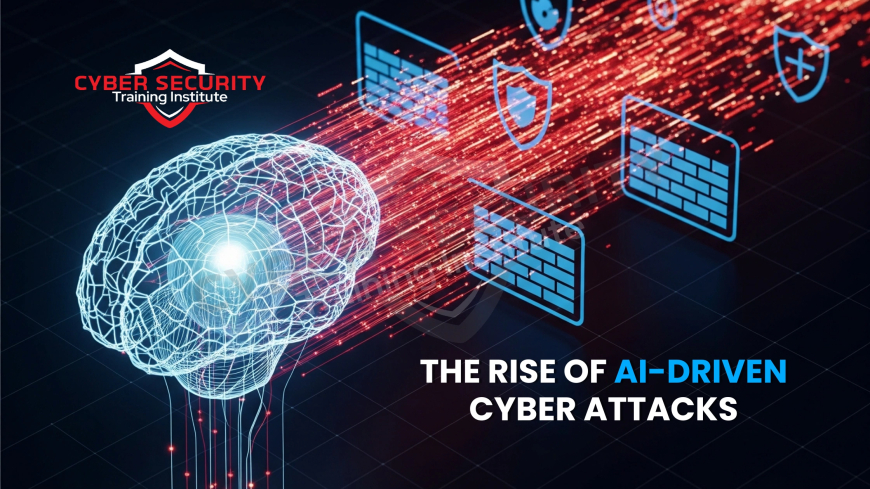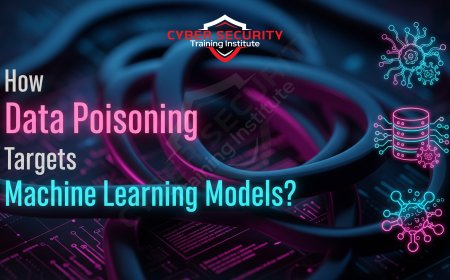The Rise of AI-Driven Cyber Attack | How to Stay One Step Ahead
Imagine receiving an email that looks like it’s from your boss, perfectly mimicking their tone, but it’s a trap designed to steal your company’s secrets. In 2025, this isn’t just a clever scam—it’s an AI-driven cyber attack, where artificial intelligence powers sophisticated hacks like never before. With global cybercrime costs hitting $10.5 trillion annually, AI is transforming the battlefield, enabling hackers to craft smarter phishing schemes, deepfakes, and automated attacks at lightning speed.26 But here’s the good news: businesses can fight back using AI’s own strengths. In this blog post, we’ll explore the rise of AI-driven cyber attacks, how they work, and practical ways to stay one step ahead. Written in a clear, beginner-friendly way, this guide is for anyone—from small business owners to IT pros—looking to protect their digital world. Let’s dive in and learn how to outsmart these cutting-edge threats!

Table of Contents
- What Are AI-Driven Cyber Attacks?
- Why AI Is a Game-Changer for Hackers
- Common Types of AI-Driven Attacks
- How Hackers Use AI to Target Companies
- Real-World Examples of AI-Driven Attacks
- The Impact of AI-Driven Attacks
- How to Defend Against AI-Driven Attacks
- The Role of AI in Cybersecurity Defense
- Conclusion
- FAQs
What Are AI-Driven Cyber Attacks?
AI-driven cyber attacks are malicious activities powered by artificial intelligence, where hackers use AI tools to plan, execute, or scale their attacks. AI, which mimics human thinking to analyze data and make decisions, allows hackers to create smarter, faster, and harder-to-detect threats. Think of it like giving a thief a super-smart robot assistant that can pick locks, forge keys, and evade alarms—all in seconds.
These attacks target businesses, governments, or individuals, exploiting weaknesses in software, networks, or human behavior. In 2025, 25% of cyberattacks involve AI, up from 10% in 2022, as hackers leverage its speed and precision.
Why AI Is a Game-Changer for Hackers
AI gives hackers an edge by automating and enhancing their tactics:
- Speed: AI processes vast data instantly, finding vulnerabilities faster than humans.
32 - Precision: It crafts targeted attacks, like personalized phishing emails.
33 - Scale: AI automates attacks across thousands of targets simultaneously.
32 - Adaptability: AI learns from defenses, adjusting tactics to bypass them.
15 - Deception: Creates realistic fakes, like deepfake voices or videos.
32
In 2024, AI-powered attacks reduced detection time by 50%, making them stealthier.
Common Types of AI-Driven Attacks
AI fuels a range of attack types, each more cunning than traditional methods:
- AI-Powered Phishing: Emails or messages tailored to trick specific users, mimicking trusted contacts.
33 - Deepfakes: Fake audio or video used to impersonate executives for fraud.
32 - Automated Malware: AI-crafted viruses that evolve to dodge antivirus software.
10 - Credential Stuffing: AI tests stolen passwords across multiple platforms at scale.
15 - Adversarial AI: Manipulates AI defenses to create false negatives, hiding attacks.
32
These methods exploit human trust and system gaps, making them tough to spot without advanced defenses.
How Hackers Use AI to Target Companies
Hackers wield AI strategically to maximize damage:
- Data Harvesting: AI scrapes social media or public records to craft personalized attacks.
33 - Vulnerability Scanning: AI probes software for weaknesses, like zero-day flaws.
15 - Attack Automation: Bots launch thousands of attacks, like phishing, in minutes.
32 - Social Engineering: AI mimics trusted voices or emails to trick employees.
32 - Evasion Tactics: AI alters malware to bypass detection tools.
10
AI’s ability to learn and adapt makes these attacks feel like a chess game where hackers anticipate your moves.
Real-World Examples of AI-Driven Attacks
Real cases show AI’s impact. In 2023, an AI-generated deepfake voice of a CEO tricked a finance team into transferring $35 million.
A 2025 attack used AI to exploit a zero-day flaw in a cloud provider, affecting 10,000 businesses.
The Impact of AI-Driven Attacks
AI-driven attacks hit businesses hard:
- Financial Loss: Breaches average $4.45 million, with AI attacks often higher.
2 - Reputation Damage: Customer trust plummets after data leaks.
32 - Operational Downtime: Systems offline for hours or days disrupt work.
24 - Legal Penalties: GDPR fines for data breaches hit €1.7 billion in 2024.
14 - Competitive Harm: Stolen trade secrets weaken market position.
26
The speed and scale of AI attacks amplify these impacts, making prevention critical.
How to Defend Against AI-Driven Attacks
Businesses can stay ahead with proactive strategies:
- Employee Training: Teach staff to spot phishing and deepfakes.
17 - Regular Patching: Update software to fix vulnerabilities.
10 - Zero-Trust Security: Verify every user and device, no exceptions.
21 - Network Segmentation: Limit attack spread by isolating systems.
14 - Threat Intelligence: Share data on new AI threats.
20
These steps act like layers of armor, slowing down even AI-powered attacks.
The Role of AI in Cybersecurity Defense
AI isn’t just for hackers—it’s a powerful defense tool:
- Threat Detection: AI spots anomalies, like unusual logins, in real-time.
32 - Phishing Defense: Analyzes emails for AI-crafted fakes.
33 - Automated Response: Isolates threats instantly, like locking infected systems.
14 - Predictive Analysis: Forecasts attack patterns based on data.
32
Here’s a table comparing AI’s offensive and defensive roles:
| AI Use | Hackers | Defenders |
|---|---|---|
| Phishing | Crafts targeted emails | Detects fakes via text analysis |
| Malware | Creates evasive viruses | Spots new malware patterns |
| Automation | Scales attacks | Automates threat response |
| Deepfakes | Mimics voices/videos | Identifies fakes via AI |
In 2025, 80% of organizations use AI defenses, reducing breach costs by 30%.
Conclusion
In 2025, AI-driven cyber attacks are reshaping cybersecurity, with hackers using AI to craft faster, sneakier, and more damaging threats. We’ve explored what these attacks are, why AI empowers hackers, their common types, how they target companies, real-world examples, impacts, and defense strategies. From deepfakes to automated malware, AI attacks are a growing menace, costing billions. But businesses can fight back with employee training, zero-trust models, and AI-powered defenses. The key is staying proactive—leveraging AI to match hackers’ ingenuity. Start strengthening your defenses today to stay one step ahead in this high-stakes digital race.
FAQs
What are AI-driven cyber attacks?
Attacks using artificial intelligence to plan, execute, or scale malicious activities.
Why is AI a game-changer for hackers?
It speeds up attacks, targets precisely, and creates convincing fakes.
What is AI-powered phishing?
Personalized fake emails crafted by AI to trick users.
What is a deepfake?
Fake audio or video, like impersonating a CEO, created by AI.
How do hackers use AI?
To scan vulnerabilities, automate attacks, and mimic trusted contacts.
What is adversarial AI?
AI that manipulates defenses to hide attacks.
How much do breaches cost?
Average $4.45 million, with AI attacks often costing more.
What was the 2023 CEO deepfake scam?
An AI-generated voice tricked a team into transferring $35 million.
Can small businesses be targeted?
Yes, AI attacks hit any company using digital systems.
What is zero-trust security?
Verifying every user and device to prevent unauthorized access.
How does AI help defenders?
It detects threats, analyzes phishing, and automates responses.
What is threat intelligence?
Sharing data on new cyber threats to improve defenses.
Can training stop AI attacks?
It helps employees spot phishing and deepfakes, reducing risks.
What is credential stuffing?
AI testing stolen passwords across multiple platforms.
Are AI attacks common?
They make up 25% of cyberattacks in 2025.
What is network segmentation?
Isolating systems to limit attack spread.
Can AI detect deepfakes?
Yes, by analyzing patterns in audio or video.
Why are AI attacks hard to detect?
They’re fast, adaptive, and blend with normal activity.
What is automated malware?
AI-crafted viruses that evolve to avoid detection.
How to stay ahead?
Use AI defenses, train staff, and adopt zero-trust security.
What's Your Reaction?
 Like
0
Like
0
 Dislike
0
Dislike
0
 Love
0
Love
0
 Funny
0
Funny
0
 Angry
0
Angry
0
 Sad
0
Sad
0
 Wow
0
Wow
0
















